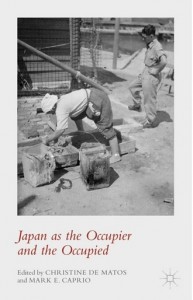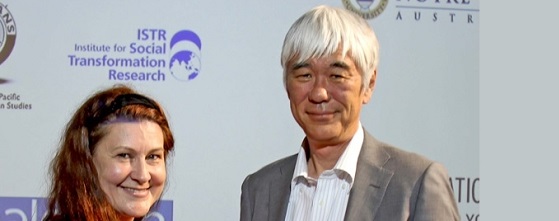… Christine de Matos discusses the work involved in editing a volume of essays.
The year 2015 marked the centenary of Gallipoli, seen as the most important for Australia in a range of Great War centenaries that fall between 2014 and 2018. Less noticeably, 2015 also marked 70 years since the end of that other major 20th century conflict, the Asia Pacific War/World War II (1945-2015).
Quite serendipitously, I published a six-year-long edited book project, Japan as the Occupier and the Occupied, in this ‘other’ anniversary year. The book, co-edited with Mark E. Caprio, published by Palgrave Macmillan, and launched on 18 November at The Japan Foundation, Sydney, seeks to cross the historical divide created by the moment of Japan’s 1945 defeat.
Historians like to impose order on the past and thus Japan’s history has become segregated into its pre and post-1945 dimensions. As editors we rejected the artificiality of that division. Instead we sought to illuminate and understand both changes and continuities in Japan and its colonised and occupied territories at the moment when Japan’s position in the power dynamic suddenly switched from that of occupier to the occupied.
Launching the book presented the opportunity to reflect upon its making. My talk focussed on the theme of journeys: in content, through the constant movement of people across national borders, as colonisers, forced labourers, soldiers, POWs, repatriates; through the contributors, as we travelled to gather at conferences and workshops to develop and connect our ideas; and via the book itself, as the spark of an idea was shaped into a collaborative published work.
As an historian who works in academe, and who has now published three edited books, it has become obvious that the edited book is undervalued as part of ‘research output’. Published research is subject to a sea of acronyms – HERDC, ERA, IRMA – and reduced to a numerical classification: ‘1’ for a journal article, ‘5’ for a sole-authored book. What is the number for an edited book? That would be zero. Well, a ‘1’ for each chapter authored, but there is no classification for coordination of the project – that is, no numerical recognition for much of the six years of work. In universities, things like workloads and research funding are tied to these acronyms and numbers.
Why then bother once, let alone three times, you might ask. Editing a book is hard work. You need to locate willing contributors, replace those who leave along the way, find a way to evict those who do not produce quality work by the very, very last deadline. You need to put in applications for funding to run workshops or attend conferences (the e-world might be useful for much of the time, but nothing beats brainstorming minds physically gathered in a room). You need to submit book proposals, find expert readers for every chapter, go through several rounds of editing (I have a minimum of three). Chase up AWOL contributors. Let alone write your own chapter/s and introduction, decide on the order of chapters (and should we have sections?), put together title pages, dividers, contributor notes, contents page, the index, lists of figures and tables, references. Find photos for the cover, check permissions and copyright. Format all of this consistently, fill in endless forms. Negotiate with publishers and check the work of copyeditors.
Phew!
And yet I find it such a rewarding experience, both in the course of the collating and that moment when you proudly hold the completed, beautiful product in your hand. Japan as the Occupier and the Occupied was a transnational and multidisciplinary project, with contributors from Japan, Southeast Asia and Australia.
As editors you are able to present readers a broader view of the topic from a variety of expert scholars with different backgrounds, foci and perspectives, yet with much greater coherence and depth than a journal issue. Your own work grows and develops through contact with others you might not otherwise have met. And you make friends across the country and globe that may even lead to future research collaborations. It is about being part of a project that is greater than oneself.
My fear is that without some form of recognition amongst the acronyms and numbers, the edited book will lose favour, its journey will end and we might talk of a pre and a post-edited book world. That would be a great intellectual loss indeed.

Congratulations, Christine. The PHA is proud to have members such as yourself who do such significant work. There needs to be a campaign to have the work of editing such a compilation appropriately recognised in academia.
Thanks Pauline!
This is a thought provoking post Christine. You have opened my eyes by explaining the value to historians involved in producing the edited book, both in terms of advancing the knowledge in a particular area, but also encouraging collegiality among researchers. The latter is valuable but difficult to measure but it sounds like the production of an edited book would be a good measure for that.
As a reviewer of histories for people interested in history, but who are not necessarily historians, I have avoided reviewing edited collections. This is because I have assumed that this form is generally one for a scholarly audience. Do you think that this is an erroneous assumption on my part? Do you think that some of these type of books could become cross-over publications and develop deeper public discourse on certain topics?
Great comments Yvonne. I think that quite a number of edited books would be too specialised or too theoretical for many readers outside of the area. I also think there needs to be a more general discussion of the meaning of impact in academic circles – do we just want to talk to each other, or do we want to engage with the general public? I definitely think there needs to be more of the latter. But until it is recognised as ‘legitimate’ scholarship, it is unlikely to happen.
My Dad read this edited book – and *said* he enjoyed it. But I guess he has to, doesn’t he!?
Christine, congratulations and thank you for taking on the often thankless task of putting together an edited collection. These collections are not only valuable additions to historical discourse on a range of subjects and themes but are often a great way for young historians and early career researchers to get their work published for the first time. This goes for young academics and researchers as well as for professional and public historians.
Good work and keep it up.
Thanks Mark. Yes, you are right. I always try to have at least one early career researcher in my collections – and this one is no exception.